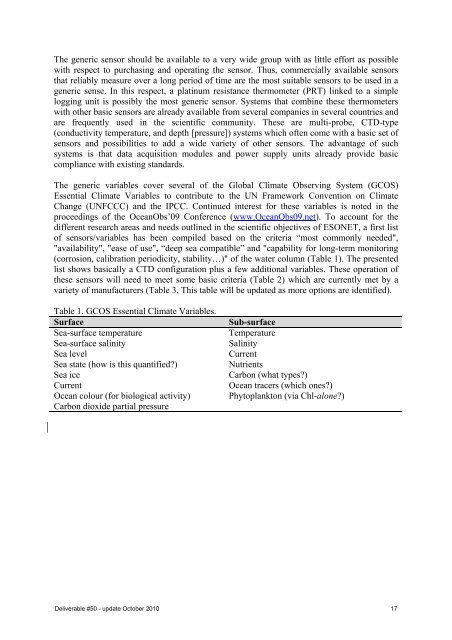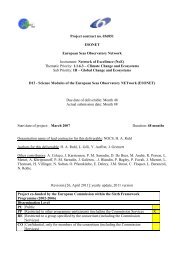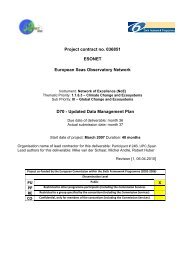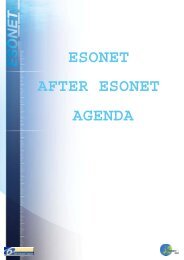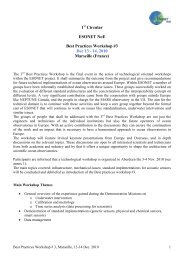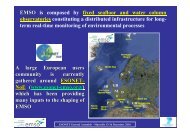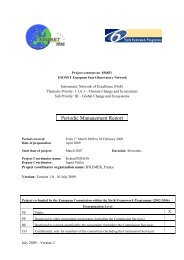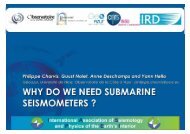Project Deliverable D50 Report on Best Practices ... - ESONET NoE
Project Deliverable D50 Report on Best Practices ... - ESONET NoE
Project Deliverable D50 Report on Best Practices ... - ESONET NoE
You also want an ePaper? Increase the reach of your titles
YUMPU automatically turns print PDFs into web optimized ePapers that Google loves.
The generic sensor should be available to a very wide group with as little effort as possible<br />
with respect to purchasing and operating the sensor. Thus, commercially available sensors<br />
that reliably measure over a l<strong>on</strong>g period of time are the most suitable sensors to be used in a<br />
generic sense. In this respect, a platinum resistance thermometer (PRT) linked to a simple<br />
logging unit is possibly the most generic sensor. Systems that combine these thermometers<br />
with other basic sensors are already available from several companies in several countries and<br />
are frequently used in the scientific community. These are multi-probe, CTD-type<br />
(c<strong>on</strong>ductivity temperature, and depth [pressure]) systems which often come with a basic set of<br />
sensors and possibilities to add a wide variety of other sensors. The advantage of such<br />
systems is that data acquisiti<strong>on</strong> modules and power supply units already provide basic<br />
compliance with existing standards.<br />
The generic variables cover several of the Global Climate Observing System (GCOS)<br />
Essential Climate Variables to c<strong>on</strong>tribute to the UN Framework C<strong>on</strong>venti<strong>on</strong> <strong>on</strong> Climate<br />
Change (UNFCCC) and the IPCC. C<strong>on</strong>tinued interest for these variables is noted in the<br />
proceedings of the OceanObs’09 C<strong>on</strong>ference (www.OceanObs09.net). To account for the<br />
different research areas and needs outlined in the scientific objectives of <strong>ESONET</strong>, a first list<br />
of sensors/variables has been compiled based <strong>on</strong> the criteria “most comm<strong>on</strong>ly needed",<br />
"availability", "ease of use", “deep sea compatible” and "capability for l<strong>on</strong>g-term m<strong>on</strong>itoring<br />
(corrosi<strong>on</strong>, calibrati<strong>on</strong> periodicity, stability…)" of the water column (Table 1). The presented<br />
list shows basically a CTD c<strong>on</strong>figurati<strong>on</strong> plus a few additi<strong>on</strong>al variables. These operati<strong>on</strong> of<br />
these sensors will need to meet some basic criteria (Table 2) which are currently met by a<br />
variety of manufacturers (Table 3, This table will be updated as more opti<strong>on</strong>s are identified).<br />
Table 1. GCOS Essential Climate Variables.<br />
Surface Sub-surface<br />
Sea-surface temperature Temperature<br />
Sea-surface salinity Salinity<br />
Sea level Current<br />
Sea state (how is this quantified?) Nutrients<br />
Sea ice Carb<strong>on</strong> (what types?)<br />
Current Ocean tracers (which <strong>on</strong>es?)<br />
Ocean colour (for biological activity) Phytoplankt<strong>on</strong> (via Chl-al<strong>on</strong>e?)<br />
Carb<strong>on</strong> dioxide partial pressure<br />
<str<strong>on</strong>g>Deliverable</str<strong>on</strong>g> #50 - update October 2010 17


